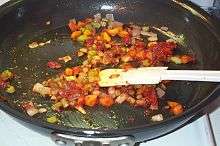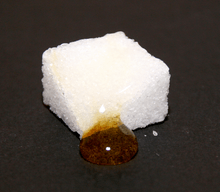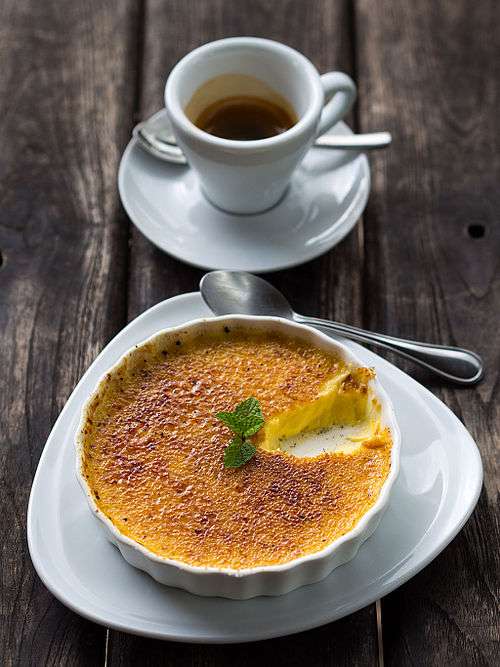Caramelization
Caramelization is the browning of sugar, a process used extensively in cooking for the resulting sweet nutty flavor and brown color. The brown colors are produced by three groups of polymers: caramelans (C24H36O18), caramelens (C36H50O25), and caramelins (C125H188O80). As the process occurs, volatile chemicals such as diacetyl are released, producing the characteristic caramel flavor.[1]
Like the Maillard reaction, caramelization is a type of non-enzymatic browning. Unlike the Maillard reaction, caramelization is pyrolytic, as opposed to being a reaction with amino acids.
When caramelization involves the disaccharide sucrose, it is broken down into the monosaccharides fructose and glucose. [2]
Process

Caramelization is a complex, poorly understood process that produces hundreds of chemical products, and includes the following types of reactions:
- equilibration of anomeric and ring forms
- sucrose inversion to fructose and glucose
- condensation reactions
- intramolecular bonding
- isomerization of aldoses to ketoses
- dehydration reactions
- fragmentation reactions
- unsaturated polymer formation
Effects on caramelization

The process is temperature-dependent. Specific sugars each have their own point at which the reactions begin to proceed readily. Impurities in the sugar, such as the molasses remaining in brown sugar, greatly speed the reactions.
| Sugar | Temperature |
|---|---|
| Fructose | 110 °C (230 °F) |
| Galactose | 160 °C (320 °F) |
| Glucose | 160 °C (320 °F) |
| Sucrose | 160 °C (320 °F) |
| Maltose | 180 °C (360 °F) |
Caramelization reactions are also sensitive to the chemical environment, [4] and the reaction rate, or temperature at which reactions occur most readily, can be altered by controlling the level of acidity (pH). The rate of caramelization is generally lowest at near-neutral acidity (pH around 7), and accelerated under both acidic (especially pH below 3) and basic (especially pH above 9) conditions. [5]
Uses in food
Caramelization is used to produce several foods, including:
- Caramel sauce, a sauce made with caramel
- Confiture de lait and Dulce de leche, caramelized, sweetened milk
- Caramel candies
- Creme Caramel, and the similar Crème Brûlée, a custard dish topped with sugar caramelized with a blowtorch
- Caramelized onions, which are used in dishes like French onion soup. Onions require 30 to 45 minutes of cooking to caramelize.[6][7]
- Caramelized potatoes
- Caramelized pears [8]
- Cola, of which some brands use caramelized sugar in small amounts for color
Note that the preparation of many caramelized foods also involves the Maillard reaction; particularly recipes involving protein- and/or amino acid-rich ingredients.
References
- Miller, Dennis (1998). Food Chemistry: A Laboratory Manual. Wiley-Interscience. ISBN 978-0471175438.
- Woo, K. S.; Kim, H. Y.; Hwang, I. G.; Lee, S. H.; Jeong, H. S. (2015). "Characteristics of the Thermal Degradation of Glucose and Maltose Solutions". Prev Nutr Food Sci. 20 (2): 102–9. doi:10.3746/pnf.2015.20.2.102. PMC 4500512. PMID 26175997.
- Food-Info on caramelization
- McGee, Harold. "Caramelization: new science, new possibilities". Retrieved 10 May 2019.
- Villamiel, M.; del Castillo, M. D.; Corzo, N. (2006). "4. Browning Reactions". In Hui, Y. H.; Nip, W-.K.; Nollet. L. M. L.; Paliyath, G.; Simpson, B. K. (eds.). Food biochemistry and food processing. Wiley-Blackwell. pp. 83–85. ISBN 978-0-8138-0378-4.
- Scocca, Tom. Layers of Deceit: Why do recipe writers lie and lie and lie about how long it takes to caramelize onions? Slate.com, May 2, 2012.
- Child, Julia. "French Onion Soup". Archived from the original on 2012-05-02. Retrieved 2017-03-08.
- "Caramelizing Pears | Stemilt". Stemilt. 2016-10-10. Retrieved 2016-10-27.
